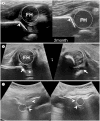[Pediatric Hip Disorders]
- PMID: 38873372
- PMCID: PMC11166597
- DOI: 10.3348/jksr.2024.0021
[Pediatric Hip Disorders]
Abstract
Developmental dysplasia of the hip is a condition characterized by hip joint instability due to acetabular dysplasia in infancy, necessitating precise ultrasound examination. Legg-Calvé-Perthes disease is caused by a temporary disruption in blood flow to the femoral head during childhood, progressing through avascular, fragmentation, re-ossification, and residual stages. Slipped capital femoral epiphysis is a condition where the femoral head shifts medially along the epiphyseal line during adolescence due to stress, such as weight-bearing. Differentiating between transient hip synovitis and septic arthritis may require joint fluid aspiration. Osteomyelitis can be associated with soft tissue edema and osteolysis. When multiple lesions are present, it is essential to distinguish between Langerhans cell histiocytosis and metastatic neuroblastoma. This review will introduce imaging techniques and typical findings for these conditions.
발달성 고관절 이형성증은 영아기 비구 형성이상으로 인해 고관절 불안정성이 발생하는 질환으로 정확한 초음파 검사가 이루어져야 한다. 특발성 대퇴골두 무혈성 괴사는 아동기 대퇴골두의 일시적인 혈류 장애로 인해 발생하며 무혈성, 분절화, 재골화, 잔여기 단계를 거치게 된다. 대퇴골두 골단분리증은 청소년기에 체중 부하와 같은 스트레스로 인해 대퇴골두가 골단선을 따라 내측으로 전위되는 질환이다. 일과성 고관절 활액막염과 화농성 관절염은 감별을 위해 관절액 흡인술이 필요할 수 있다. 골수염은 연부 조직 부종과 골 용해를 동반할 수 있다. 하지만, 다발성 병변의 경우 랑게르한스 세포 조직구증, 전이성 신경모세포종 등을 감별해야 한다. 본 종설에서는 이런 질환에 대한 영상 검사 방법 및 대표적인 소견을 소개하고자 한다.
Copyrights © 2024 The Korean Society of Radiology.
Conflict of interest statement
Conflicts of Interest: The authors have no potential conflicts of interest to disclose.
Figures














References
-
- Barrera CA, Cohen SA, Sankar WN, Ho-Fung VM, Sze RW, Nguyen JC. Imaging of developmental dysplasia of the hip: ultrasound, radiography and magnetic resonance imaging. Pediatr Radiol. 2019;49:1652–1668. - PubMed
-
- Dezateux C, Rosendahl K. Developmental dysplasia of the hip. Lancet. 2007;369:1541–1552. - PubMed
-
- Bache CE, Clegg J, Herron M. Risk factors for developmental dysplasia of the hip: ultrasonographic findings in the neonatal period. J Pediatr Orthop B. 2002;11:212–218. - PubMed
-
- Nguyen JC, Dorfman SR, Rigsby CK, Iyer RS, Alazraki AL, Anupindi SA, et al. ACR appropriateness criteria® developmental dysplasia of the hip-child. J Am Coll Radiol. 2019;16(5S):S94–S103. - PubMed
-
- Shipman SA, Helfand M, Moyer VA, Yawn BP. Screening for developmental dysplasia of the hip: a systematic literature review for the US preventive services task force. Pediatrics. 2006;117:e557–e576. - PubMed
Publication types
LinkOut - more resources
Full Text Sources

